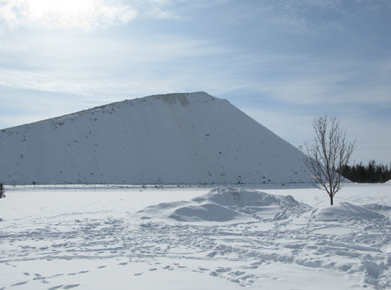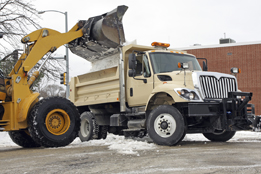Module 7 Project
1. Module 7 Project
Module 6: Surface Area
Module 6/7 Project: Clear the Roads!
Note: You read about the Module 6/7 Project in Module 6. The information here is the same information you read in Module 6.

Parts of Canada are known for their long, cold winters. The eighteenth-century philosopher and historian Voltaire dismissed Canada as a “few acres of snow,” but Canadians know that a large part of the appeal of this country is its extremes of climate. Of course, winter sports, such as hockey, snowmobiling, and skiing, help define the national character! Nevertheless, having snow for six months, or longer, in many parts of the country does present problems for work, travel, and transporting goods.
Most urban areas budget for snow removal on city streets, and private contractors are hired to clear snow from parking lots at schools, businesses, and community centres. The photograph, taken in February 2011, shows a mountain of snow in a storage area on the western outskirts of Edmonton. The snow hauled from city roads was graded and compacted by track-type tractors to make the pile more than 50 m high. If you look closely, you can see a fence that is 2.5 m in height along the snow pile’s base.
Goal

iStockphoto/Thinkstock
Your goal for this project is to plan the snow removal from a large parking lot or stretch of roadway in your community. As part of your plan, you will apply your knowledge of surface area, volume, and capacity.
Time
You should be able to complete this project in approximately six hours.
Steps
Step 1: Select a parking lot or a stretch of roadway in your community. A parking lot at a hospital, school, or mall will work well. Explain why you made this selection.
Step 2: Draw a rough sketch of the parking lot you chose.
Step 3: Use appropriate measuring tools or the ruler in Google Maps to determine the dimensions of your parking lot.
Step 4: Draw a diagram of your parking lot to scale.
Step 5: Determine the surface area (in square metres) from which the snow would be removed. Show the calculations used to determine the area.
Step 6: Find out what the average annual snowfall, in centimetres, is in your community. One possible source is to search the Internet using these keywords: “Environment Canada climate normals and averages.”
Step 7: Use this data to determine the average annual volume of snow (in cubic metres) that must be removed from the parking lot. Show the calculations you used to determine the volume.
Step 8: When snow is graded or is being cleared, the snow is compacted. The degree of compaction varies. Use 30% compaction as an estimate. Determine the volume, in cubic metres, of compacted snow that would have to be hauled away by truck. Simply determine 70% of the snow volume you determined in Step 7. Show all calculations.
Step 9: By checking with the maintenance department of your local municipal office or by researching online, determine the capacity of a truck used in snow removal. Describe the truck and indicate your source. Draw a diagram with measurements to support your answer.
Step 10: Determine the number of truckloads it takes to remove the average annual snowfall from the selected parking lot. Show your calculations.
Step 11: From your snow volume estimates, determine the volume of water, in cubic metres and in litres, that results when all the snow melts. The moisture content of snow varies. You should use 10 m3 of compacted snow:1 m3 of water as an estimate.
Step 12: How many Olympic-sized swimming pools could you fill with the volume of water you calculated in Step 11? An Olympic-sized pool must be 50 m long, 25 m wide, and at least 2 m deep. You will first have to calculate the capacity of a pool with these dimensions.
How You Will Be Evaluated
Your teacher will use the following rubric to evaluate your project. You can print or save a digital copy of the Project Rubric to complete your project self-assessment.
| MODULE 6/7 PROJECT RUBRIC | ||||
| Score | Required Concepts |
Connections | Mathematical Calculations | Communication for Final Report |
3 Exceeds Acceptable Standard |
Each of the first seven steps outlined in the project has been addressed. | Explanations show solid understanding of connections between the mathematics of scale and the required model and related three-dimensional diagrams used in this project. |
All required mathematical representations are completed, correct, and support explanations. | The work is presented in a neat, clear, organized fashion that is easy to read and/or see. Images and documents are used to support explanations. |
2 Meets Acceptable Standard |
Five or six of the first seven steps have been addressed. | Explanations show substantial understanding of connections between the mathematics of surface area, volume, and capacity and the requirements of this project. | There may be some minor errors or flaws in the mathematical calculations. | The work is presented in an organized fashion but may be hard to read and/or see at times. Diagrams are included. |
1 Below the Acceptable Standard |
Four or fewer of the first seven steps have been addressed. | The response shows little understanding of connections between the mathematics of surface area, volume, and capacity and the requirements of this project. | There are major mathematical calculation errors or serious flaws in reasoning. | The work appears sloppy and/or disorganized. It is hard to know what information goes together. Images and documents may not be used, or are referred to inappropriately. |
0 Does Not Meet the Minimum Standard |
Three or fewer of the steps have been addressed. | The response shows a lack of understanding of connections between the mathematics of surface area, volume, and capacity and the requirements of this project. | There is not an understandable attempt at using mathematical representations. | There is not an understandable presentation of project work. |
Total Score / 12 |
/3 | /3 | /3 | /3 |